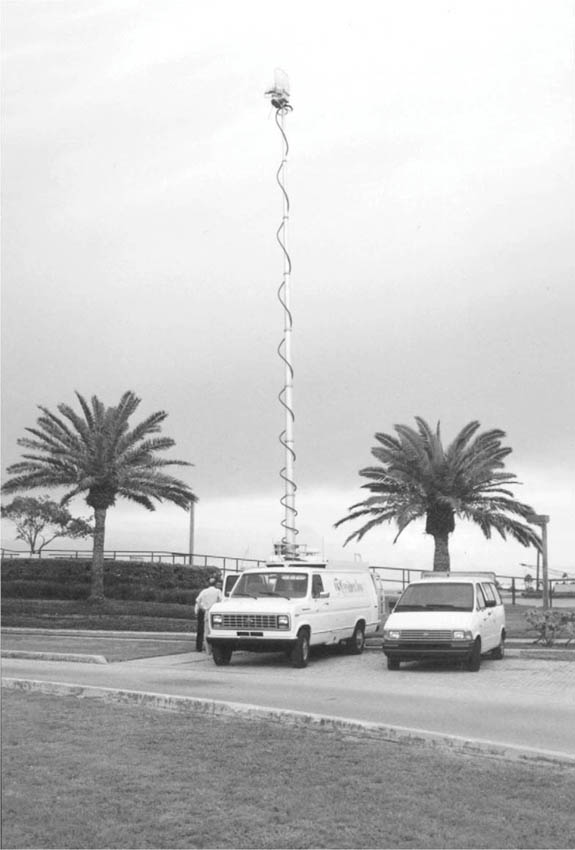Trucks and masts
The thing about news is it can happen anywhere, and ENG equipment has to be both portable and reliable. This therefore means that the microwave link has to be portable (and reliable!), as it is deployed from base to a temporary location, rigged, used, and then de-rigged and taken either back to base or on to another story – all within a matter of hours.
There are different ways of using terrestrial microwave to cover a story. It can be mounted:
• on a truck, van or sports utility vehicle (SUV)
• in a helicopter or light aircraft to give live aerial shots
• carried on someone’s back – a man-pack link
• mounted on the ENG camera itself.
We will start off by looking at vehicles, as this is by far the most common way of using ENG microwave.
When the microwave link equipment is fitted into a truck, it is also common for there to be space for some production facilities. This is because, as we have seen earlier, there is usually a need to both record and playback the material from a VTR, as well as offer some limited vision, switching and audiomixing facility. Radio talkback is also often required, as we mentioned earlier, so the vehicle has to be large enough to be able to accommodate all of this equipment.
This is particularly true when you realize that the links truck will also have a telescopic mast, with the microwave transmitter unit and the antenna permanently mounted at the top. It is almost given that you will need height to achieve a clear get-away for the link, and the mast will (hopefully) help lift the transmitter clear of any local obstructions, and try to achieve a line of sight to the receiver. This means that the ENG vehicle will either be based on a large panel van, an SUV, or a four-wheel drive vehicle.
Types of ENG trucks (a © Wolf Coach; b © Frontline Communications)

The mast will typically extend to 12–17m (40–55 feet), and is constructed as a series of hollow telescopic tube sections each extended by pumping compressed air into the mast base, pushing each of the sections up. This is called a pneumatic mast, as shown in the following figure.
Instead of using compressed air, some masts work by the use of tensioned cables within the mast, which are driven by a winch at the bottom – but pneumatic masts are the most common type found in use.
In addition to a control panel for the operation of the mast itself, the microwave transmitter at the top of the mast is operated from a control panel within the vehicle, which allows a number of settings (parameters) to be set and controlled. We will look at the operation of such a link in a moment.
The back of any ENG van (or SNG truck, for that matter) is used as an area for carrying all the ancillary items required to make live TV happen on any street corner.
The back of the vehicle typically carries the following:
• video and audio cables to connect a camera to the truck
• rubber matting to cover cables where they cross pavements, etc.
• rope and safety tape
• tools
• ladder for accessing the vehicle roof or other areas
• the kitchen sink!
Pneumatic mast on ENG vehicle

The last point is actually quite serious. Particularly where a van is used by a number of different operators, there is a great temptation to add extra items ‘just in case’ without checking to see if they are already on board. The result can be an overloaded vehicle, as weight is a key issue in the operation of these vehicles. ENG and SNG vehicles are often built ending up fairly close to their maximum legally permissible weight, and there is often not enough consideration of all the extra equipment that gets added after it has left the manufacturer.
The back of a working ENG van

